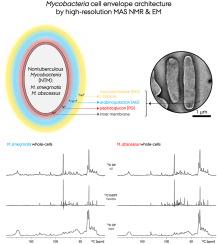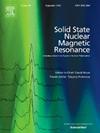高分辨率二维固态核磁共振有助于深入了解非结核分枝杆菌。
IF 2.4
3区 化学
Q4 CHEMISTRY, PHYSICAL
引用次数: 0
摘要
我们介绍了一项高分辨率魔角旋转(MAS)固态核磁共振(ssNMR)研究,用于描述非结核分枝杆菌(NTM)的特征。我们研究了两种不同的非结核分枝杆菌菌株:烟曲霉分枝杆菌(一种非致病的模式菌株)和脓肿分枝杆菌(一种新出现的重要人类病原体)。我们对水合非结核分枝杆菌样本进行了天然丰度研究,而没有进行同位素标记,研究对象包括全细胞和细胞包膜分离物,以及原生样本和固定样本制备物。我们利用 1D13C 和 2D 1H-13C ssNMR 光谱和峰值解卷积来确定 NTM 细胞壁化学位点。在 ssNMR 光谱中发现了超过 100 个不同的 13C 信号。我们利用基于二维 INEPT 的 1H-13C ssNMR 光谱中分辨率较高的 1H/13C 化学位移,对 30 ∼ 种多糖进行了初步鉴定。利用基于 CP 或 INEPT 的 13C ssNMR 光谱,可选择性地分析来自全细胞细菌样品柔性部分和刚性部分的信号。通过 CP 积累曲线,可以深入了解 NTM 菌株细胞壁成分的动态相似性。肽聚糖、阿拉伯半乳聚糖和霉菌酸的信号已被确定。大多数 13C 信号不受整个细胞样本固定的影响。分离的细胞包膜核磁共振波谱与全细胞波谱有很大程度的重叠,后者有更多的信号。ssNMR和EM数据表明,脓肿霉菌的细胞壁由较小的肽聚糖层组成,与烟曲霉菌相比更具柔韧性,这可能与其致病性更强有关。在这项工作中,我们首次使用了高分辨率二维 ssNMR 来表征 NTM 菌株并确定化学位点。这些结果将有助于开发基于结构的方法来对抗 NTM 感染。本文章由计算机程序翻译,如有差异,请以英文原文为准。

High-resolution 2D solid-state NMR provides insights into nontuberculous mycobacteria
We present a high-resolution magic-angle spinning (MAS) solid-state NMR (ssNMR) study to characterize nontuberculous mycobacteria (NTM). We studied two different NTM strains, Mycobacterium smegmatis, a model, non-pathogenic strain, and Mycobacterium abscessus, an emerging and important human pathogen. Hydrated NTM samples were studied at natural abundance without isotope-labelling, as whole-cells versus cell envelope isolates, and native versus fixed sample preparations. We utilized 1D13C and 2D 1H-13C ssNMR spectra and peak deconvolution to identify NTM cell-wall chemical sites. More than ∼100 distinct 13C signals were identified in the ssNMR spectra. We provide tentative assignments for ∼30 polysaccharides by using well resolved 1H/13C chemical shifts from the 2D INEPT-based 1H-13C ssNMR spectrum. The signals originating from both the flexible and rigid fractions of the whole-cell bacteria samples were selectively analyzed by utilizing either CP or INEPT based 13C ssNMR spectra. CP buildup curves provide insights into the dynamical similarity of the cell-wall components for NTM strains. Signals from peptidoglycan, arabinogalactan and mycolic acid were identified. The majority of the 13C signals were not affected by fixation of the whole cell samples. The isolated cell envelope NMR spectrum overlap with the whole-cell spectrum to a large extent, where the latter has more signals. As an orthogonal way of characterizing these bacteria, electron microscopy (EM) was used to provide spatial information. ssNMR and EM data suggest that the M. abscessus cell-wall is composed of a smaller peptidoglycan layer which is more flexible compared to M. smegmatis, which may be related to its higher pathogenicity. Here in this work, we used high-resolution 2D ssNMR first time to characterize NTM strains and identify chemical sites. These results will aid the development of structure-based approaches to combat NTM infections.
求助全文
通过发布文献求助,成功后即可免费获取论文全文。
去求助
来源期刊
CiteScore
5.30
自引率
9.40%
发文量
42
审稿时长
72 days
期刊介绍:
The journal Solid State Nuclear Magnetic Resonance publishes original manuscripts of high scientific quality dealing with all experimental and theoretical aspects of solid state NMR. This includes advances in instrumentation, development of new experimental techniques and methodology, new theoretical insights, new data processing and simulation methods, and original applications of established or novel methods to scientific problems.

 求助内容:
求助内容: 应助结果提醒方式:
应助结果提醒方式:


